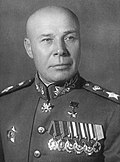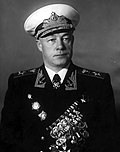Top Qs
Timeline
Chat
Perspective
Minister of Defence (Soviet Union)
Soviet government minister From Wikipedia, the free encyclopedia
Remove ads
The Minister of Defence of the Soviet Union (Russian: Министр обороны СССР) refers to the head of the Ministry of Defence who was responsible for defence of the socialist/communist Russian Soviet Federative Socialist Republic from 1917 to 1922 and the Soviet Union from 1922 to 1992.
Remove ads
People's Commissars for Military and Naval Affairs (1917–1934)
Remove ads
People's Commissar for the Armed Forces (1946)
Ministers of the Armed Forces (1946–1950)
Ministers of Defence (1953–1992)
Remove ads
See also
Notes
- The committee of the People's Commissars for Military and Naval Affairs consisted of Vladimir Antonov-Ovseenko, Pavel Dybenko, and Nikolai Krylenko. On 10 November 1917 Ovseenko was taken hostage during the Petrograd Junker mutiny and was released next day with the help of American journalist Williams. Later Ovseenko headed the Petrograd Military District until December when he was dispatched to Ukraine. Dybenko continued to supervise the naval affairs as the Supreme Navy College that was formed sometime in late November. He stayed in charge until 16 March 1918 when he was stripped of all posts and revoked membership in the Bolshevik Party due to desertion. On 25 November 1917 Krylenko was appointed the Supreme Commander-in-Chief of the Red Army.
- Dismissed by Nikita Khrushchev in the aftermath of the Anti-Party Group affair.
- Dismissed by Mikhail Gorbachev as a result of the Mathias Rust affair.
- Dismissed by Mikhail Gorbachev for being a member of the GKChP during the 1991 coup attempt.
- On 14 February 1992, by the decision of the Council of CIS Heads of State, Marshal Yevgeny Shaposhnikov was appointed Commander-in-Chief of the United Armed Forces of the CIS.
Remove ads
References
Wikiwand - on
Seamless Wikipedia browsing. On steroids.
Remove ads






















